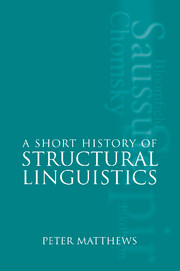7 - Structural semantics
Published online by Cambridge University Press: 03 December 2009
Summary
The term ‘semantics’ was coined in the 1880s, by the French linguist Michel Bréal. As ‘phonétique’ was in its widest sense a science of the sounds of speech, so ‘sémantique’, from the Greek verb for ‘to mean’, was a ‘science des significations’ (Bréal, 1911 [1897]: 8). How Bréal saw this discipline need not concern us. But for a structuralist a language is a system in which determinate forms are related to meanings that are also determinate. ‘Structural semantics’ is accordingly concerned with meanings as terms in such systems.
Its beginnings lie in Saussure's theory of ‘linguistic signs’ (2.1). Each sign, as we have seen, had two sides; and just as on the level of expression, to use Hjelmslev's terminology, units were identified in abstraction from the sounds that speakers physically utter, so those on the content level had to be abstracted from the passing meanings that were intended. This second task was therefore, in principle, as important as the first. But when Hjelmslev wrote he was himself among the few who had approached it seriously. We have seen how, by his test of commutation, both expressions and their contents were divided into ‘figurae’: ‘[ram]’, for example, into ‘[r]’ plus ‘[a]’ plus ‘[m]’; ‘ram’, in parallel, into ‘he’ plus ‘sheep’ (5.1). Another parallel, as we will soon see, was between semantic oppositions and distinctive phonetic features in Prague School phonology (3.2).
Information
- Type
- Chapter
- Information
- A Short History of Structural Linguistics , pp. 118 - 141Publisher: Cambridge University PressPrint publication year: 2001
